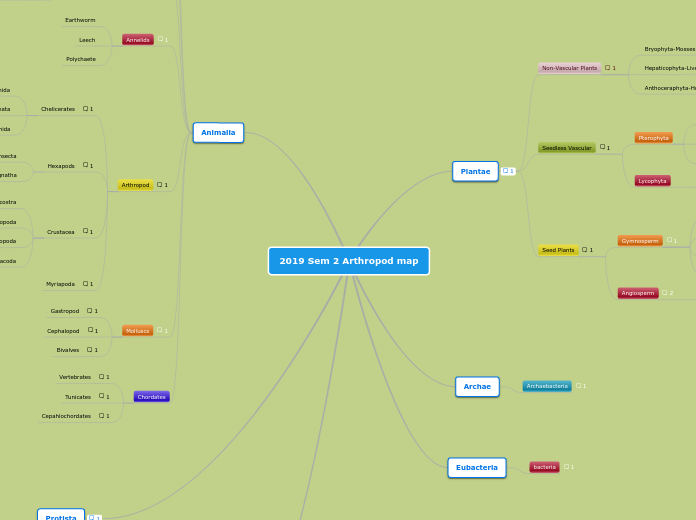por Rohit Hundal - David Suzuki SS (2662) 6 anos atrás
779
2019 Sem 2 Arthropod map

por Rohit Hundal - David Suzuki SS (2662) 6 anos atrás
779

Mais informações
decompose, cause disease, first to enter new ecosystem, key in soil, produce own food using chlorphyll, some as parasites, sexual and asexual reproduction
-Most Diverse Kingdom
-All protists are aquatic
-Mostly Unicellular
-Heterotrophic or autotrophic
-Motile using flagella, pseudopods or cilia
-Many organelle
Brain eating amoeba
filter feeders, ancestors of vertebrates resembled these creatures
filter feeds, motile
has backbone that leads to brain has 3 parts neck,head,trunk, presence of tail, jointed internal skeleton, two pairs of appendages, closed circulatory system, red blood cells, 2-4 chambered hearts, respiratory system, 2 layered skin
body plan (complex internal organs)
foot
shells
mantle
coelom body cavity
clams oysters and gallops, two part shell, no head, powerful foot
fast moving and intelligent, feet are tentacles, moved by jet propulsion
snails and slugs, have a radula (used to drill into the shells of other molluscs)
-Joint Appendages
-most successful phylum
-hard exoskeleton
-segmented body
-has to molt in order to grow
-biggest phylum
mandibles
-Mandibles
-Biramous appendages (branches in two)
-Compound eyes
Ostracoda
Branchiopoda
Maxillopoda
Malacostra
mandibles, antennae, legs(uniramous), head thorax abdoman, 3 pairs of legs and commonly 2 wings, appendages connected to thorax.
Entognatha
Insecta
no antenna, 6 pairs of appendages chelicerae mouth
Pycnogonida
Merostomata
Arachnida
segmented (has repeating units)
digestive tract
closed circulatory system
-Head and tail
carnivores, scavengers, most of the time they are aquatic
-Assymetrical
-No tissues
-Asexual and sexual reproduction
-Made of spicule
unicellular prokaryotes, lack membrane bound organelle
coccus- circles
bacillus- longer oval
spirillum- ~
endotoxin- cause light fever
exotoxin- really bad
includes some of the most extreme environments on the planet
ways to spread
-airborne
-arthropods
-contact
-Multicellular
-Photosynthetic
-Alternation in generations
-Come from embryos
-Made through sexual fusion
Transition from aquatic to terrestrial
-stand upright
-prevents loss of moisture, waxy coating, cuticle, stomata
-tissue that move water and waste, xylem (water and dissolved material) and phloem (sugar transport)
-Gametophyte is reduced
-Gametophte are not free living
-Zygote is in seed and protected
-Pollination replaces sperm cell for reproduction process
-Reproduction happens in a flower
Monocot- One cotyledon
Dicot- Two cotyledons
Anthophyta-Flowering Plants
-naked seeds
-sporophtye produces cones for both female and male
Gnetophytes
Ginkophyta-Ginkgo
Cycadophyta-Cycads
Coniferophtya-Conifers
-Have Vascular Tissues
-Live in moist habitats
-Leaves that are called Fronds
Club Mosses
Horsetails
Whisk Ferns
Ferns
-Found in moist habitats most of the time
-Lack Vascular tissues
-Most smaller than 20cm